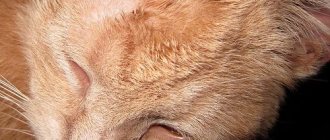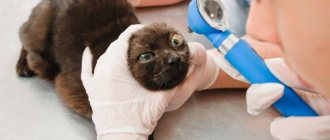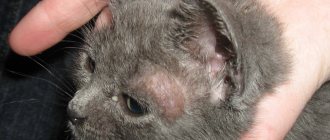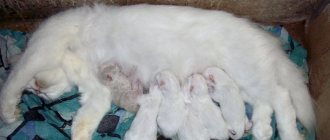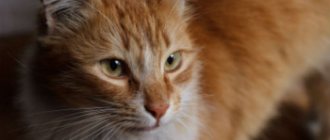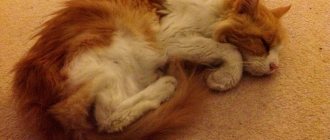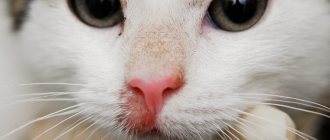Ringworm in cats is a fungal infection of an animal. What is the cause of the disease? In the first place is infection. Reduced immunity, allergies, and viruses are also prerequisites for the disease. More recently, 20 years ago, even 10 years ago, the disease was considered incurable. Pets were euthanized. Fortunately, today lichen in cats and kittens can be treated. The disease is contagious; it can infect other animals and, which is very unpleasant, people.
It is necessary to be vigilant and at the first signs of deprivation (we will talk about them a little later) not to self-medicate, but, having grabbed your pet, come to an appointment with a veterinarian for an accurate diagnosis. Many people encounter this for the first time, panic, search on forums, ask friends what to do? Yes, you can listen to advice, but! you should calm down and come with your cat to a doctor's consultation. By being patient and receiving the necessary treatment methods, you can help your pet recover.
In the article we will talk about the types of ringworm, its symptoms, and will dwell in more detail on the treatment of ringworm and prevention.
Types of lichen
There are several types of lichen. They differ not only in external signs, but are also treated differently.
- Lichen planus;
- Pink or herpes zoster;
- Ringworm or eczema;
- Pityriasis versicolor;
- Ringworm.
Lichen planus is characterized by the appearance of red blisters on the cat's skin. It itches constantly, the blisters burst, causing severe itching. Red bubbles appear in the groin, abdomen, and on the bends of the joints. The mucous membranes are affected. This type of lichen in a cat signals that not everything is ok with the immune system. The good news is that this shingles is not spread to other animals or people.
Pityriasis rosea in a cat is a sign of a viral infection. How does it manifest itself? Pink spots ranging in size from 1.5 to 2 cm appear on the animal’s body. The cat itches and the skin peels off. Then the stain becomes crusty. Ringworm usually goes away on its own. During the period of exacerbation, the animal should not be washed or released into the sun. You need to take care of his healthy diet. There is no consensus in the scientific world about whether pityriasis rosea in cats is dangerous or not.
With weeping lichen, red bubbles appear, filled with liquid, which are very painful. Ringworm or eczema is rare. The disease can be caused by a malfunction in the immune system, the presence of parasites, allergies to food and detergents. This type of lichen is not contagious.
Let's look at what pityriasis versicolor (varicolored) lichen in cats is. This type of lichen is very contagious for humans and is easily transmitted to other animals. It is also called “sun fungus” and “beach lichen”. Oval spots of pink, brown, pale yellow color appear on your pet's body, growing very quickly. Pityriasis versicolor requires long-term and serious treatment.
Ringworm
Now let’s take a closer look at what ringworm is in a cat. It is one of the most dangerous and common types of lichen. What is the danger and insidiousness of this disease? The fact is that the incubation period for lichen in cats can last from several days to several months. Other animals and unsuspecting people become infected. It is especially dangerous for long-haired breeds, since the hair prevents the first signs of the disease from being seen. How to treat ringworm in cats will be discussed a little later.
Let's consider what is the causative agent of ringworm? These are dermatophyte molds. There are two forms of ringworm:
- - microsporia;
- - trichyphytosis.
- What happens with microsporia?
- - hair fragility appears at the skin level;
- - wool hair is easily pulled out.
When hair falls out, other animals and people become infected with fungal spores.
Trichophytosis, the second form of the fungus, is very rare. With this type of ringworm, baldness appears only in the head and neck area.
There are three forms of the disease:
- -superficial;
- -deep;
- -atypical.
With a superficial and atypical form of ringworm in cats, for a long time it is impossible to notice that the disease process has already begun.
It is very important to identify the disease at an early stage; the method and time of treatment for your pet will depend on this.
Who is at risk and can get ringworm?
- -most often these are small kittens;
- - long-haired breeds (genetically predisposed to such diseases);
- - cats with malignant processes in the body;
- - cats infected with parasites;
- -young cats up to one year of age.
One of the most pressing and exciting questions is how is lichen transmitted from cats? Unfortunately, ringworm is contagious to humans. You love your pet, pet it, pick it up. Yes, usually upon contact the process of lichen infection occurs. This happens especially easily if there are scratches, wounds, or abrasions on your hands. You can become infected by dandruff, scales, and hair falling from a cat. Children can become infected very easily while playing in the sandbox. Your home, bowls, rugs, combs, etc. are contaminated. Fungal spores are very stable and viable. Will the person get sick or not? It depends on the type of lichen and the person’s immunity. Children and people with weakened immune systems are at risk.
Sources of infection, risk factors and pathogenesis
Ringworm of fungal and viral origin is transmitted by contact: after contact with a sick animal, through shared objects.
Dermatophyte spores also live in the soil, so they enter the house on outdoor shoes and clothes or with street air. Mice and rats become carriers.
Ringworm, regardless of the variety, is more common in animals with weakened immune systems.
Predisposing factors:
- chronic diseases;
- viral and bacterial infections;
- unbalanced diet;
- helminths and ectoparasites;
- long-term medication use.
The risk group includes kittens, elderly and young cats under one year old: their immune system either has not had time to strengthen or has weakened. The likelihood of infection with the fungus increases in long-haired animals and those who walk unattended.
Each type of lichen begins with a single lesion with damaged or lost hairs. Further development is different. With any disease of fungal etiology, new foci appear over time, they grow and merge. In the absence of treatment, the lesion becomes generalized and bacterial infectious diseases are added.
With rosacea, one maternal spot also appears first, then others surround it, but after 1–2 months they spontaneously disappear. The development of eczema is difficult to predict: the disease fades away if the causes are identified and eliminated in time.
How to avoid getting shingles from a cat?
Firstly, do not have contact with stray animals and do not allow children to do this. After walking, be sure to wash your hands. If you have a cat, take it to the vet to have it checked for ringworm. Clean the apartment regularly using disinfectants. Be sure to treat your cat for parasites. It is important to provide your pet with a nutritious diet; this helps maintain its good condition, increases immunity, and therefore the skin’s resistance to infections.
Now let’s look at where cats get lichen from? Your pet can become infected through contact with a sick animal. And even without communicating with one, yours can become infected simply by walking in the country. Ringworm spores can be found on the soil. Sometimes you yourself are the cause of your absolutely domestic furry's illness. The fact is that you can bring fungus into your home on clothes, shoes, and things. Sometimes small children infect their pets. The child stroked a cute cat on the street and, when he came home, stroked his own. And that’s it, contact happened.
What can be observed with all types of lichen in cats:
- - hair falls out;
- - the skin becomes inflamed and peels;
- - areas of the skin become inflamed;
- - severe itching appears;
How to identify ringworm in a cat at home?
- -one of the first signs that should alert you is that the cat scratches itself often, eats poorly, and does not behave as usual. What happens, what should you pay attention to, how does lichen begin in cats?
- - round flaky spots appear. In some cases, spots appear all over the body. Ringworm often appears in cats on the ears, paws, and face. It all depends on the specific pathogen;
- - crusts form at the spots;
- - hair falls out;
- - your cat itches a lot, often chews and scratches spots;
- - scabs appear along the spine;
- -spots expand and take on an oval shape;
- - in places where the rash appears, the hair thins and the hairs become sparse;
- - the spots grow, if treatment is not started, your pupil will die.
Briefly about the atypical form of ringworm. The fact is that the signs of lichen described above in this form of the disease are absent or not clearly expressed. The disease proceeds unnoticed, since only individual hairs are affected. This is the danger of this disease. The owner does not suspect anything, since he does not see signs of infection, does not take any measures for a long time, and the disease develops.
Symptoms
Before we talk about how to treat a cat for lichen, you need to understand the symptomatic picture.
You should be alert to the following signs:
- hair loss in local areas of the skin;
- purulent formations, vesicular nodes, and scaly discharge are visible on the lesions;
- there is annoying itching;
- in some cases, when the lesion affects a large area of the body, peeling appears and the coat becomes greasy and unkempt.
Despite everything, the first symptoms of the disease remain increased shedding, balling of fur, anxiety, frequent scratching, and the appearance of an unpleasant white coating in the undercoat.
How to determine if a cat has lichen or not?
If you suspect that something is wrong with your cat, do not delay visiting the veterinarian. This will save your time, nerves, and money on treatment. Skin diseases are mostly similar to each other. Even an experienced specialist will not be able to determine by eye what is wrong with your animal? To determine an accurate diagnosis, there are methods such as instrumental and laboratory tests. Using these methods, it is determined that your pet has allergic dermatitis or contagious ringworm.
Initially, the doctor examines your cat, interviews you, if there is a medical record, studies it. Then, after the examination, the examination begins.
- Your pet is scanned under a Wood's fluorescent lamp. Under a Wood's lamp, a cat's lichen glows green. This method is not accurate, because harmless microbes can glow and, conversely, pathogenic microbes do not glow.
- The next method is to scrape the skin or affected hair and examine it under a microscope. It's called trichoscopy. The result is also fast, but not one hundred percent. It is not always possible to detect a fungal infection, but this does not mean that the disease does not exist.
- Sowing a culture of a pathogenic fungus in a nutrient medium is the most accurate and reliable way to determine lichen. To do this, collect the crust and scales, which are placed in a Petri dish. After a certain time (you need to wait about three weeks to get the result), a diagnosis is made. This method is used if the disease has not been cured for a long time. The analysis helps you choose the right medications to cure your cat of lichen.
- Additionally, a blood test is taken. They examine whether your pet has chronic diseases and determine the presence of parasites.
You can undergo treatment in a clinic or at home. Most cats are treated by the owners themselves. How to treat lichen in a cat at home? Follow all the veterinarian's instructions; do not interrupt the course of treatment if you think that everything is already in order. Consult your doctor about what to feed your cat. Mandatory treatment of your home, this will be discussed further.
Diagnosis of the disease
Ringworm behind a cat's ear
If you notice any of the symptoms described above in your four-legged friend, you need veterinary help . Only a doctor who will conduct the appropriate tests can confirm the presence of lichen or another disease Ringworm can be confused with vitamin deficiency, another type of fungus, but you can’t do nothing about it.
How does a doctor diagnose lichen?
1Take a scraping from the affected area of the animal’s skin. In the laboratory, the resulting material is examined, and if a fungus is present, its sensitivity to antibiotics is determined.
2Conducts a Wood's lamp examination. This fluorescent lamp is available in any veterinary clinic. This diagnostic tool emits light in the ultraviolet spectrum, under which areas of the skin affected by the fungus glow.
Features of the Wood's lamp glow
Glow of ringworm under a Wood's lamp
Before you start diagnosing with a Wood's lamp, you must:
- Wash the affected area of skin and clean it;
- Turn on the warm-up lamp for 1-2 minutes;
- Create darkness in the room;
- Direct the glow of the lamp onto the skin, holding the device at a distance of 10-30 cm.
Skin without infection will have a slight blue glow. Also, healthy but thickened areas may appear white, oily areas may appear yellow, and dehydrated skin will appear purple.
With ringworm, the glow under the lamp depends on the type of fungus . If the infection arose as a result of microsporia, then the light will be blue-green , and with trichophytosis - pale blue . If the suspicious area of skin glows more clearly under the influence of a Wood's lamp, then the fungus test is positive.
Positive test for shingles
How to remove lichen from a cat?
Treatment by a professional is the most correct and reliable method of treatment. There are also folk remedies. More on them later.
Treatment for ringworm in cats depends on the severity of the disease, the breed of the cat, its age, immunity, the presence of chronic diseases, and pregnancy. During treatment, different drugs are used. For local treatment - these are ointments, creams, sprays, drops, shampoos. For severe cases of the disease, tablets, vitamins and immunomodulators are prescribed. Vaccines are also used. Now let's look at some of the drugs used in treatment.
For example, Clotrimazole for lichen in cats. During the initial treatment of deprivation in a cat with Clotrimazole, the veterinarian gives her an injection and treats the infected areas with the drug. The product is available in the form of gels, solutions, creams, tablets, and injections. It is found on sale as Candizol, Amyclone and Fungin.
Veterinarians advise cat owners to have Clotrimazole ointment in their home medicine cabinet; they also use it for inflammatory processes. Scheme for treating ringworm in an animal with Clotrimazole ointment: lubricate the infected areas with ointment two to three times a day, applying a thin layer, gently rubbing. Do it within a week. Repeat after three to four weeks, lubricate once or twice a day. What to do if the areas are very large? First, wash the affected area with soap and water and dry. Then apply Clotrimazole ointment three to four times daily for three to four weeks.
Terbinafine, a broad-spectrum drug, is also used to treat ringworm in cats. Available in tablets, ointments, creams. Terbinafine ointment is applied in a thin layer to the infected areas once or twice a day. During healing, crusts form on the wounds, which must be removed with a cotton pad moistened with water.
The healing process can last 30 days or more. It all depends on the severity of the disease and the fungus. Very important: do not self-medicate! Anti-lichen tablets for cats are prescribed only by a specialist when the disease is severe, as they have side effects. The doctor prescribes the dosage and regimen of medications.
Now about the vaccine. Abroad (in Europe and America), the lichen vaccine is not used for cats. In Russia, the lichen vaccine for cats is used for both treatment and vaccination. The most common of them:
- Vakderm;
- -Microderm;
- -Polivak TM.
What does the shingles vaccination give? This is an opportunity to protect the animal from infection for a long time. The following must be taken into account:
- -Vaccination from the age of two months;
- -Contraindications – cat pregnancy;
- -The cat must be healthy. If she was sick, then the vaccine can be done after two or even three weeks;
- -10-14 days before the lichen vaccination, you must give an anti-worm tablet. To get rid of skin parasites, bathe your cat with a special shampoo.
- - Conduct a diagnosis for ringworm under a Wood's lamp.
Animals usually tolerate lichen vaccination easily.
There is an opinion that vaccination against lichen is not necessary for cats. Whether to do it or not, you decide for yourself.
The main means of combating ringworm in cats remain antifungal drugs and mandatory hygiene.
Ringworm shampoo for cats must be used in the treatment of the disease. These are special shampoos containing Miconazole, Ketocanazole, Epilconazole. They are usually used twice a week for 5-6 weeks. The most popular of them are Nizoral and Sebozol. You cannot cure your cat of ringworm using shampoo alone. They are used only in complex therapy.
Sulfur ringworm ointment is also used to treat cats. Apply to the affected area, covering another 2-3 cm around 1-2 times a day for a week.
YAM BK ointment is often used in the treatment of lichen in cats. The affected area is treated, covering another 2-3 cm nearby 1-2 times a day. Using a cotton swab or swab, gently rub in the ointment twice a day. Treatment time is from 4 to 10 days.
Reviews about the use of potassium permanganate against lichen in cats differ. Some people find the use of potassium permanganate effective. Yes, in the case of ringworm, the use of potassium permanganate is justified. If an animal has pityriasis rosea, the use of potassium permanganate is prohibited, as it can provoke the appearance of eczema. Wash the wounds with a weak solution of potassium permanganate and lubricate the sores. When treating ringworm in cats, a solution of potassium permanganate and a solution of hydrogen peroxide are often combined. First, drop potassium permanganate and then a drop of peroxide. The procedure is safe and effective.
Ringworm spray for cats is the most convenient remedy used for external treatment of cats against lichen. It is applied to sore spots, lightly rubbing. Repeat 2-3 times a day.
When treating cats with lichen using external means, they must wear a protective collar made in the form of a mouthpiece. Many products are toxic, and this will prevent the animal from licking them.
Quite conflicting opinions exist about the treatment of lichen in cats with iodine. Just look at the forum and read the reviews. Can lichen be treated with iodine? Some argue that it is possible. Others categorically deny. Based on the first statement: it can be cured at the initial stage by lubricating small affected areas 2 times a day. Why not? Iodine causes skin burns.
Disinfection and prevention
When your pet is completely cured of the skin disease, it is necessary to treat the apartment for cat lichen. Sometimes it is not possible to disinfect an apartment. In such situations, the owners do not know what to do with the cat during treatment.
One option is to place him in a specialized clinic. While your pet is away, you need to thoroughly clean the entire room and wash all surfaces with bleach.
To prevent lichen, you need to get vaccinated in a timely manner, comb your pet's fur more often, bathe it once a week with soap, and not allow it to come into contact with other cats. This way you can significantly reduce the risk of developing lichen.
Your cat's health can be preserved with timely diagnosis and proper treatment. Without proper treatment, skin infections will develop stronger and stronger, which will lead to a worsening of the animal’s general condition.
Folk remedies for treating lichen.
There are also folk remedies for the treatment of ringworm in cats. This is especially true for healing pregnant cats, since many drugs used in treatment are harmful to them and their offspring. The most popular of them:
- -warm mixture of aloe juice and olive oil (1:1 ratio). Lubricate the affected areas;
- - treat with iodine solution twice a day;
- - treat wounds with celandine;
- -sprinkle the infected areas with newspaper ash 3-4 times a day;
- – mix lemon juice and olive oil in equal doses and apply warm to sore spots four times a day;
- - decoctions of herbs from valerian, chamomile, burdock, plantain, yarrow, tricolor violet, etc. are used. Herbs are used in combination or separately.
Remember: it is impossible to cure lichen in a cat with folk remedies, since it is a fungal disease. Ointments and preparations are available both in price and in their availability. For treatment to be effective, you must follow all the veterinarian’s instructions.
What to do if your cat has shingles?
- -After the diagnosis has been established and treatment prescribed by a veterinarian, it is necessary to treat your home. It is very good if the animal can be isolated, which is not always possible. No contact with children!
- -Treat a sick pet on special bedding (ideally disposable), wearing disposable gloves and protective clothing. After the procedure, disinfect things.
- – In the house, treat not only the floors, but also the doors, baseboards, corners, cracks, cabinet and upholstered furniture. Carry out wet cleaning with the addition of disinfectants.
- -Wash bed linen regularly.
- – Vacuum the room using disposable bags – dust collectors.
There are a lot of chemical solutions for effective surface treatment, but given their high cost, not everyone can buy them. You can use available tools:
- -A solution of bleach with water in a ratio of 1:10. They wash floors with it.
- -A saturated solution of laundry soap (1:6), also for washing the floor.
- -Solution of medical ethyl alcohol 96% with water (1:10). They treat all surfaces except upholstered furniture. Upholstered furniture is vacuumed.
Symptoms of lichen in humans from cats
As mentioned above, ringworm is contagious to humans. Children are infected first, then people with weakened immune systems and allergy sufferers. What happens to a person infected with lichen from a cat?
After infection, the disease may appear from several days to several weeks. Ringworm can appear on the body, nails, and head. Peeling spots appear on the skin, spots grow, and the skin turns red. Round, flaky bald spots appear on the head (the area looks as if someone has shaved it), and grayish spots appear on the nails, which leads to their fragility. Unlike cats, lichen in humans generally occurs without complications. If you discover suspicious, unknown skin diseases, immediately go to a dermatologist.
Danger to humans
Ringworm poses a threat to households. A person can get a dangerous fungus even if their beloved cat does not yet have manifestations of lichen, the incubation period is ongoing.
But if a child or adult has a strong immune system, the disease will not affect the skin and will not be able to multiply on human skin.
Otherwise, treatment for lichen will be protracted and will continue with a long period of rehabilitation. The main thing is to recover and prevent relapse.
Prevention of lichen in cats.
- -First of all, it’s cleanliness. Regularly wash and treat your cat's care items with antifungal agents, and change bedding periodically.
- -Bathe your pet in baths with special shampoos.
- -Pay attention to the condition of his skin.
- – Treat your home with disinfectants.
- -Limit, or better yet eliminate, contact with other animals.
- -Provide your pet with a balanced diet, including vitamins, to strengthen the immune system.
- -Show your cat to the veterinarian periodically.
If you are reading this article, then you are faced with this unpleasant disease. Don’t despair, help your pet, because her life and health are in your hands. Do not self-medicate. Follow all instructions from your veterinarian. Only you can cure your pet of lichen.


